UCSF Exclusive: Never-before-published photo and 1906 Examiner story connect staff member to legenda
Unpublished Photo & 1906 Examiner Story Connect Staff Member to Legendary Event
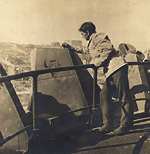
SF Examiner reporter W.H. Levings seen here after a harrowing trek up the interior of the ruined City Hall rotunda. He was positioned just below the statue of the Goddess of Liberty.
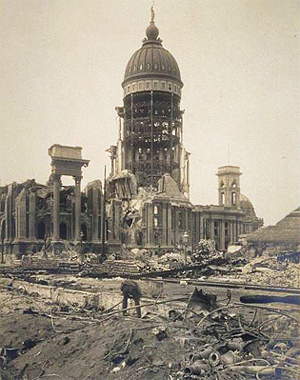
Photos of a gutted San Francisco City Hall have become an icon for the 1906 earthquake. Photo/California Digital Library
RISK LIVES TO PHOTOGRAPH
THE CITY
Members of "The Examiner" Staff Climb to Goddess of Liberty.
Perched 300 feet above the earth, cooped in the deep ball that surmounts the dome of the old City Hall, crouching at the very feet of the Goddess of Liberty, Harry J. Coleman, an "Examiner" artist, and Will H. Levings, an "Examiner" reporter, held their cameras that photographed the panoramic birdseye view of San Francisco accompany the Sunday issue of "The Examiner."
In peril of their lives, several times, as they climbed upward to the thrilling height from which the picture was taken, dodging the loose brick and mortar that fell about them, treading narrow ledges from which a fall meant sure and sudden death, picking their way over piles of debris and swinging from twisted girders to broken walls and back again, the young men finally reached the summit and through the narrow crevices of the ventilator in the big ball took the picture and safely descended to earth again.
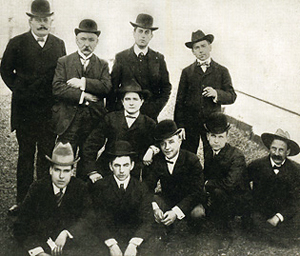
A young W.H. Levings, front row, right, is pictured here with his fellow police reporters in 1903. One of Levings' beats was the infamous Barbary Coast.
When the young man applied to Chief of Police Dinan for permit to climb to the top of the old City Hall, he flatly refused to grant one, saying that it would be equivalent to granting them the privilege of committing suicide and make him an accessory of willful self murder. But after much persuasion and after they had signed a paper acquitting both the city and the Chief of all damage in case of a fatal accident, the permit was duly granted.
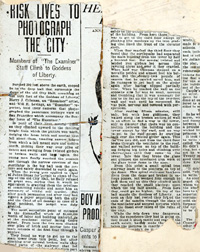
The most accessible point of entrance to the dismantled wreck of $6,000,000 worth of labor and building material, is at the southeast corner facing Grove Street. From here the two men climbed over piles of brick and mortar into the main rotunda of the first floor through a window.
They found no way to get up to the main tower from this point, but after climbing over several broken walls they found parts of the stairway that led them safely to the second floor of the building. From here there was no way to get to the third floor except by climbing like monkeys up the iron grating that lined the front of the elevator shaft.
When they reached the third floor they found that the earthquake had separated the main building from the tower by half a hundred feet. But several twisted and bended iron girders led across this yawning abyss and over it they crawled. When half way Coleman stepped on a movable pebble and almost lost his balance. But the twenty-two pounds of camera that he carried saved him, and he managed to get back on the girder again after having slipped partially over. When he reached the wall on the opposite side he was so weak, nervous and trembling that it was necessary for him to lie flat on the top of the two-foot wall and wait until he recovered. He was pale, nervous and covered with perspiration.
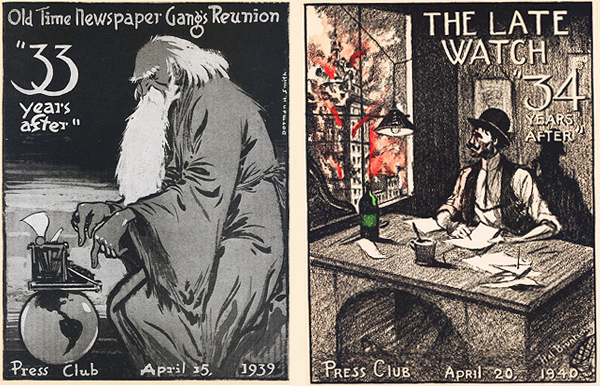
Reporters covering the 1906 earthquake were united by the searing experience and continued to gather decades later to remember. Here are three program covers from 1939, 1940 and 1941.
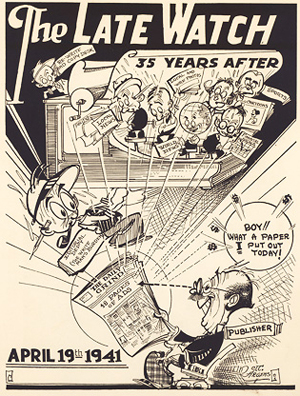
After resting fifteen minutes, still pale, but with less giddiness, they walked along the broken section of wall in an effort to find a way to the tower, only to discover that there was no connection between the building and the tower except by the roof and no way to get to the roof except by crawling back over the twisted girder again. This the two men did, and from the third floor broken through the ventilator to the roof, and walked across on top of the building dodging big holes and climbing over obstructions until they came to the tower. Into this they broken the glass and climbed the interlaced iron work of the glass inner dome to the apex.
From this point a small spiral iron stairway leads to the platform on top of the dome. This spiral staircase had been riven from the dome and broken in various places, but seemed firm enough to hold them and up this they climbed until they reached the small platform upon which the big ball stands. From here they could go no higher. On top of the ball stands the Goddess of Liberty. As soon as they had rested they found the ends of the camera through the slats of the ventilator and secured pictures which are the finest ever taken of the ruins of the city.
While the trip down was dangerous, with the experience they had in going up, they found it much easier and reached the earth safely, having made...
Photos courtesy of Susan Levings